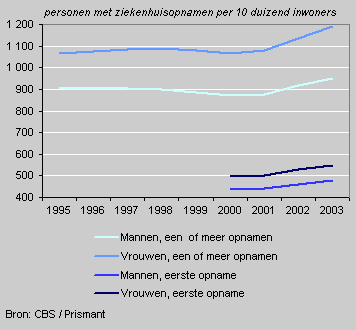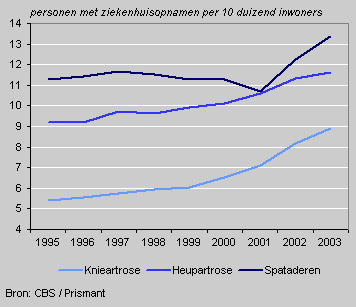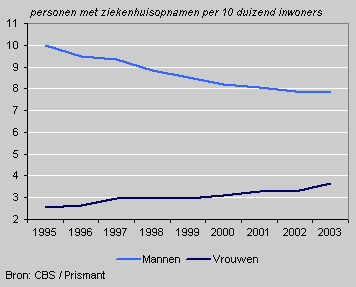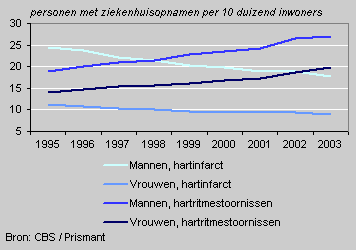More hospital admissions

In the period 1995-2003 the number of persons admitted to hospital at least once a year per 10 thousand inhabitants increased by 9 percent. In 2001 hospital admissions began to increase and the increase intensified in 2002 and 2003. At the same time the Ministry of Health, Welfare and Sports launched an action plan to reduce hospital waiting lists by making extra money available.
This is shown by the latest figures based on medical registrations and population data provided by Statistics Netherlands.
Persons admitted to hospital by gender

Persons admitted to hospital at least once for hip and knee arthrosis and varicose veins

Hospital waiting lists
As from 2001/2002 more patients on waiting lists were treated in hospitals for hip and knee arthrosis, varicose veins and cataract. In the period 1995-2003 the number of patients admitted for knee arthrosis increased by 64 percent, for hip arthrosis by 27 percent and for varicose veins by 19 percent.
Cataract treatments increased by half from 34 to 51 percent per 10 thousand inhabitants.
Persons admitted to hospital at least once for lung cancer, by gender

Lung and skin cancer
The number of patients treated in hospital who were not placed on waiting lists also changed. The number of disease cases within the population also plays a part in this respect. Between 1995 and 2003 the number of men diagnosed with lung cancer incidence fell by 22 percent, whereas the number of women diagnosed with lung cancer increased by no less than 42 percent. The number of patients diagnosed with skin cancer increased sharply: the skin cancer rate increased from 2.0 to 3.7 per 10 thousand inhabitants.
Persons admitted to hospital at least once for acute myocardial infarction and cardiac arrhythmia, by gender

Heart condition and intestinal disorders
The number of persons admitted in hospital for an acute myocardial infarction decreased by 24 percent between 1995 and 2003. The number of patients admitted in hospital for cardiac arrhythmia treatment, on the other hand, grew notably by 42 percent.
The number of persons admitted to hospital with diverticular disease, a condition of the colon, increased from 3.7 to 5.6 per 10 thousand inhabitants.
Pregnancy complications
More and more women were admitted for pregnancy complications prior to delivery: the rate rose from 80 women per 10 thousand inhabitants in 1995 to 113 in 2003. The 41 percent increase is partly caused by an increase in the number of pregnancies among older and very young women. If figures are corrected for this phenomenon, the increase in women admitted with pregnancy complications is still 23 percent.
First-time hospital admissions
Another important factor is the number of first-time hospital admissions. The number of first-time hospital admissions per 10 thousand inhabitants grew noticeably: between 2000 and 2003 the annual increase, irrespective of diagnosis, was more than 3 percent.
Gerard Verweij (CBS) and Lany Slobbe (RIVM)